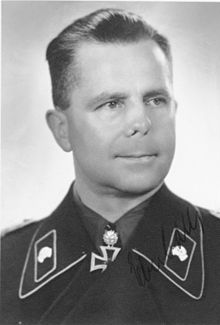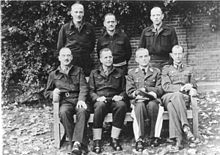Heinrich Eberbach
This article needs additional citations for verification. (March 2017) |
Heinrich Eberbach | |
|---|---|
 Eberbach in 1941 | |
| Born | 24 November 1895 Stuttgart, Kingdom of Württemberg, German Empire |
| Died | 13 July 1992 (aged 96) Notzingen, Germany |
| Allegiance | |
| Service | Army |
| Years of service | 1914–20 1935–45 |
| Rank | |
| Commands | 4th Panzer Division 5th Panzer Army 7th Army |
| Battles / wars | World War I
|
| Awards | Knight's Cross of the Iron Cross with Oak Leaves |
Heinrich Eberbach (24 November 1895 – 13 July 1992) was a German general during World War II who commanded the 5th Panzer Army during the Allied invasion of Normandy. He was a recipient of the Knight's Cross of the Iron Cross with Oak Leaves of Nazi Germany.
World War I and interwar years
[edit]Heinrich Eberbach was born on 24 November 1895 in Stuttgart, in the German Empire. Eberbach graduated with his Abitur (university-preparatory high school diploma) on 30 June 1914. On 1 July 1914, Eberbach joined the Army of Württemberg.[1] With the outbreak of World War I, Eberbach's unit was deployed on the Western Front.[2] On 16 October 1914, Eberbach was wounded in his thigh by artillery shrapnel.[3] In September 1915, Eberbach was severely wounded, losing part of his nose, and was taken prisoner of war by French forces.[3] During the 1920s Eberbach was a police officer; in 1935 he joined the Wehrmacht. In 1938 Eberbach became commander of a Panzer regiment, in the newly formed 4th Panzer Division under General Georg-Hans Reinhardt.
World War II
[edit]Eberbach participated in the German Invasion of Poland in September 1939 and then in 1940 in the Battle of France. His unit supported General Hasso von Manteuffel's offensive across the Meuse River in May. Shortly after the start of Germany's invasion of the Soviet Union in June 1941, he was assigned as commander of the 5th Panzer Brigade in Leo Geyr von Schweppenburg's XXIV Panzer Corps.
During the Battle of Moscow, Eberbach spearheaded Panzer Group 2's offensive towards Moscow as the commander of a combined-arms kampfgruppe within the 4th Panzer Division.[4] The attack began on September 30 and in only two days of fighting Kampfgruppe Eberbach had achieved a clean breakthrough, advanced over 120 kilometers, and put the entire Soviet Bryansk Front in a disastrous position while suffering negligible losses of its own.[5] Eberbach demonstrated his flexibility as a troop leader by detaching two battalions to assist the 3rd Panzer Division's efforts in the same area of operations near Bryansk, despite serving under a different division.[6] Soviet air attacks and a fuel shortage early on 2 October failed to prevent the kampfgruppe's aggressive combat leaders from advancing on the city of Orel, ending the Soviet industrial relocation efforts there and capturing a key communications hub of the Bryansk Front, on 3 October.[7] Kampfgruppe Eberbach's losses had been light: 6 tanks knocked out, 34 men killed and 121 wounded. This was a small price to pay for the complete rupturing of the Soviet lines and the capture of a city of such strategic value. 4th Panzer division had also captured 1,600 Soviet troops, mostly Kampfgruppe Eberbach's work.[8]
In March 1942 he was made commander of the 4th Panzer Division, in the German lines opposite the Russian town of Sukhinichi, roughly 120 miles west of Tula. In late November 1942 Eberbach was appointed commander of the XLVIII Panzer Corps that had just been overrun in the initial days of Operation Uranus, near the midpoint of the Battle of Stalingrad. Eberbach was soon wounded and evacuated, remaining hospitalized until February. He then became Inspector of the Armored Troops in the Home Army, was awarded the Knight's Cross of the Iron Cross and promoted to lieutenant general.
In November 1943, Eberbach became commander of troops around Nikopol and fought in battles around Zhitomir in the Soviet Union. In early 1944 Eberbach was promoted to the rank of General der Panzertruppe. During the Allied invasion of Normandy, he fought against the British landings along the 'Juno' and 'Sword' beaches. On 4 July he took command of "Panzer Group West" (later, 5th Panzer Army) after Leo Geyr von Schweppenburg was relieved (two days before). On 9 August, this force was divided, with 5th Panzer Army retreating with the most damaged units; the effective units were reorganized as Panzergruppe Eberbach.
Eberbach was directed to lead this force in the counterattack through Mortain toward Avranches that was intended to cut off the Allied forces which had broken out of Normandy. According to Eberbach's post-war memoirs, he had no confidence in the attack. When General Warlimont of OKW arrived at his HQ on 1 August to "get a closer look at the situation", Eberbach told him that "the only possible solution was an immediate retreat to the Seine-Yonne line."[9] However, Warlimont denied Eberbach's request to withdraw, and instead confirmed the order to attack.
The attack failed, and most of Panzergruppe Eberbach and 7th Army was surrounded and destroyed in the Falaise Pocket. Eberbach escaped and was given command of the remnants of 7th Army on 21 August. On 31 August Eberbach was surprised in his bed and captured by British troops at Amiens.[10] He was later presented to Lieutenant General Brian Horrocks.
Post World War II
[edit]
Eberbach was held in a prisoner-of-war camp until 1948. He participated in the work of the U.S. Army Historical Division, where, under the guidance of Franz Halder, German generals wrote World War II operational studies for the U.S. Army, first as POWs and then as employees.[11] Eberbach was the father of the naval officer Heinz-Eugen Eberbach, commander of U-967 and U-230 during World War II.[12]
Works
[edit]- Eberbach, Heinrich (1945–1954). Panzer Group Eberbach and the Falaise Encirclement. Karlsruhe, Germany: Historical Division, Headquarters United States Army, Europe, Foreign Military Studies Branch. OCLC 33089881.
Awards
[edit]- Iron Cross (1914) 2nd Class (12 October 1914) & 1st Class (10 November 1917)[13]
- Knight's Cross of the Iron Cross with Oak Leaves
- Knight's Cross on 4 July 1940 as Oberstleutnant and commander of Panzer-Regiment 35[14]
- Oak Leaves on 31 December 1941 as Oberst and commander of the 5. Panzer-Brigade[14]
References
[edit]Citations
[edit]- ^ Stockert 1996, p. 232.
- ^ Wegmann 2004, p. 339.
- ^ a b Wegmann 2004, p. 337.
- ^ Zetterling & Frankson 2012, p. 50.
- ^ Zetterling & Frankson 2012, pp. 50–54.
- ^ Zetterling & Frankson 2012, p. 53.
- ^ Zetterling & Frankson 2012, p. 54.
- ^ Zetterling & Frankson 2012, pp. 67–70.
- ^ Eberbach 1945–1954, pp. 9–10.
- ^ Arnhem, Antony Beevor, p3
- ^ Kienle 2005.
- ^ Mitcham 2009, p. 181.
- ^ Wegmann 2004, p. 340.
- ^ a b Scherzer 2007, p. 285.
Bibliography
[edit]- Kienle, Polly (2005). "Still Fighting for the Myth: German Wehrmacht Officers' Reports for the U.S. Historical Division". H-net.com. Archived from the original on 31 January 2016.
- Mitcham, Samuel W. (2009). Panzers in Normandy: General Hans Eberbach and the German Defense of France, 1944. Mechanicsburg, Pa.: Stackpole Books. ISBN 978-0-8117-4447-8.
- Scherzer, Veit (2007). Die Ritterkreuzträger 1939–1945 [The Knight's Cross Bearers 1939–1945] (in German). Jena, Germany: Scherzers Militaer-Verlag. ISBN 978-3-938845-17-2.
- Searle, Alaric (2003). Wehrmacht Generals, West German Society, and the Debate on Rearmament, 1949–1959. Westport, CT: Praeger Publishers. ISBN 978-0-275-97968-3.
- Stockert, Peter (1996). Die Eichenlaubträger 1939–1945 Band 1 [The Oak Leaves Bearers 1939–1945 Volume 1] (in German). Bad Friedrichshall, Germany: Friedrichshaller Rundblick. ISBN 978-3-9802222-7-3.
- Wegmann, Günter (2004). Die Ritterkreuzträger der Deutschen Wehrmacht 1939–1945 Teil VIIIa: Panzertruppe Band 1: A–E [The Knight's Cross Bearers of the German Wehrmacht 1939–1945 Part VIIIa: Panzer Force Volume 1: A–E] (in German). Bissendorf, Germany: Biblio-Verlag. ISBN 978-3-7648-2322-1.
- Zetterling, Niklas; Frankson, Anders (2012). The Drive on Moscow, 1941: Operation Taifun and Germany's First Great Crisis of World War II. Havertown: Casemate Publishers. ISBN 978-1-61200-120-3.
External links
[edit]- "Rommel: Ende einer Legende" [Rommel: The End of a Legend]. Der Spiegel (in German) (38). 1978. ISSN 0038-7452. Retrieved 30 May 2016.
- "Die Kraft des Bösen" [The Power of Evil]. Der Spiegel (in German) (44). 2012. ISSN 0038-7452. Retrieved 30 May 2016.
- 1895 births
- 1992 deaths
- Military personnel from Stuttgart
- People from the Kingdom of Württemberg
- German prisoners of war in World War I
- Generals of Panzer Troops
- Recipients of the clasp to the Iron Cross, 1st class
- Recipients of the Knight's Cross of the Iron Cross with Oak Leaves
- German prisoners of war in World War II held by the United Kingdom
- Reichswehr personnel
- German Army personnel of World War I
